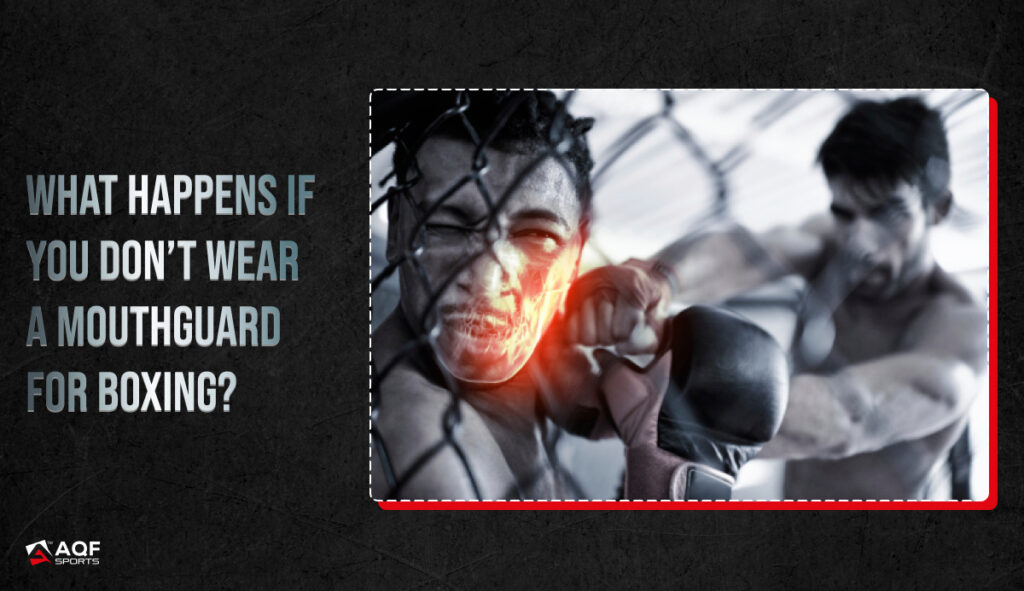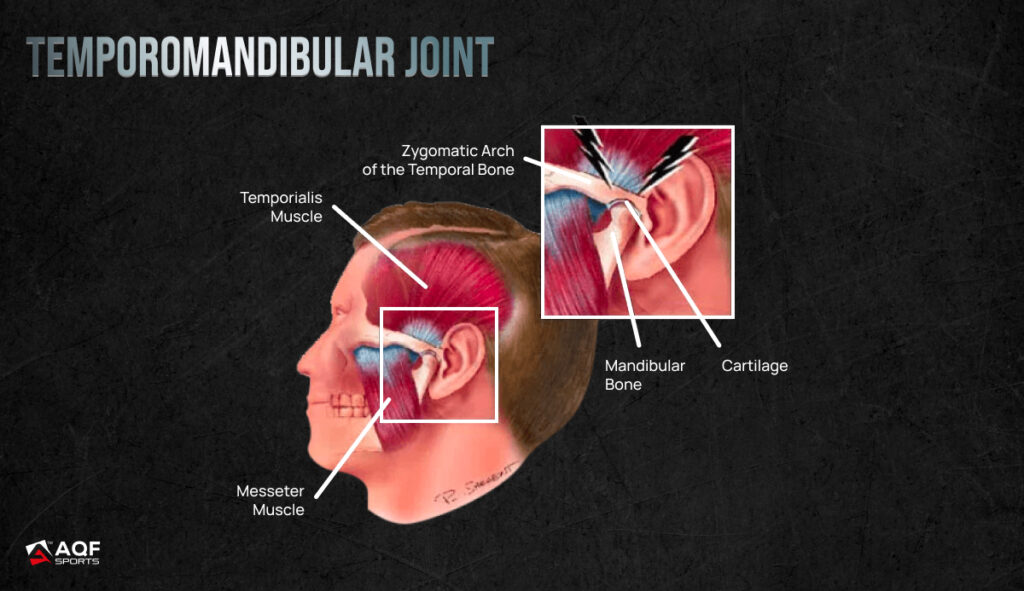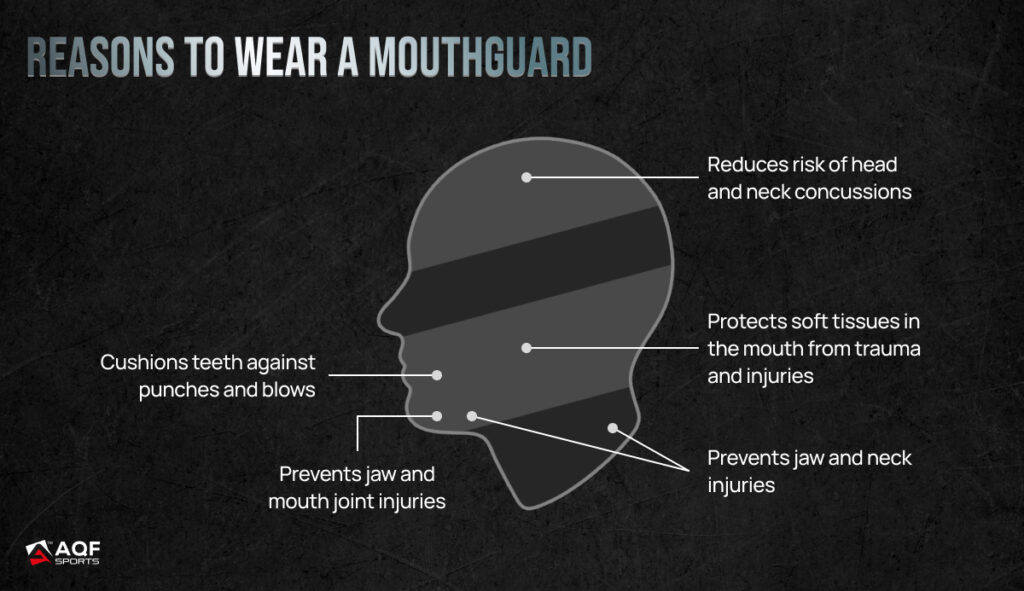Complete Guide To Choosing a Mouthguard for Boxing

You wouldn’t wanna step out of the ring with crooked teeth, torn jaw and bleeding gums, right? The minute you step into the ring, your entire body, especially your face, becomes vulnerable to punches and blows. Unfortunately, a head guard might not be enough to protect your jaw and teeth. Like MMA artists, boxers and professional athletes, you can also get a mouthguard to protect your teeth and jaw during the game. In this blog post, we bring the most important things you need to know about choosing a mouthguard. But before all that, let’s discuss how should a mouthguard fit in your mouth.
You should wear a mouthguard if you are a:
- Boxer
- Martial Artist
- High-contact sports player (like Rugby, Football, Hockey, Basketball, or Lacrosse Player)
- Skateboarder or BMX Rider
- Gymnast
- Wrestler
- Snowboarder or Skier
If you have an unhealthy habit of grinding your teeth, you can use the gum shield to get rid of it.
How Should a Mouthguard Fit?
A properly fitting mouthguard SHOULD:
- Fit comfortably in your mouth
- Completely grip your teeth and gums
- Align with your teeth level
- Stable enough to protect you from impact
A mouthguard Should:
- NOT interfere with your speaking or breathing
- NOT be uncomfortable or have sharp edges
How to Wear a Gum Shield Step-By-Step Process
Take Your Gum Shield Out of the wrapping and clean it using mild water and soap.
Tip: DON’T use harsh cleaning agents or abrasive materials that may damage the mouthguard.
Get a saucepan of water boiling on the stove. Carefully drop your mouthguard into the boiling water. Turn off the stove and let it sit in there for 15 seconds.
Tip: Use a Spoon or Tongs to avoid getting burned when submerging the mouthguard in boiling water.
Take it out of the boiling water and give it a few seconds to cool down. Again, use a spoon or tongs to do this step.
Tip: Dunk the mouthguard in Cool water for 5 Second or use the Hand Wave technique to bring the surface level temperature to a comfortable level.
Check the mouthguard temperature using your fingertips. It should be warm but not too hot.
Tip: Hot mouthguard has better moulding properties and fits your mouth better. But for your safety, cool it down to the appropriate temperature.
Watch in the mirror and Insert it in your mouth. Use your thumbs to press and centre it on your front teeth.
Tip: The curved side of the mouthguard should face outward.
Bite down on the mouthguard. Use your fingers to press and shape the mouthguard against your teeth and gums. Make sure it grips the teeth and fills the spaces in between.
Tip: It’s totally okay to bite through the inner gel layer. However, Don’t bite any further as it can deform the mouthguard.
The suck and press technique is a good trick to further improve your mouthguard fitting. Suck in the air and press on the mouthguard with your tongue and fingers.
Tip: If the mouthguard doesn’t feel quite right, don’t worry! You can always re-mould it. Check the label for more instructions.
Check for smooth edges and a comfortable fit on the mouthguard. If it feels rough or uncomfortable, press down with your fingers to smooth them out.
Tip: Try talking and moving your mouth to see if it feels comfortable.
Clean with cool water or mild mouthwash and store the mouthguard after each use.
Tip: Store the mouthguard in a clean case with some ventilation to prevent unwanted odours.

Taken from our website.
How Does a Gum Shield Work?
Gum shields are like safety helmets for your jaws and teeth. They absorb and distribute the force shock force from impacts during high-contact sports like hockey, rugby, MMA and boxing.
A high-quality mouthguard fully covers your teeth and gums and cushions your jaw against impact force. Moreover, it acts as a barrier between your upper and lower jaw to prevent jaw dislocation, teeth fractures, chipping and concussions.
According to expert dental surgeons, Gum shields absorb and distribute impact force to protect the wearer.
What Happens If You Don’t Wear a MouthGuard For Boxing?

Not wearing a mouthguard while participating in boxing can have serious consequences for your oral health. Let’s dive into the scientific evidence to understand the potential risks:
Dental Injuries:
Dental professional research reveals that athletes who don’t use mouthguards are prone to tooth fractures, tooth dislodgement, and soft tissue injuries in the mouth. Studies reveal that mouthguards are very effective against dental injuries. [1]
Painful Tooth Fractures:
Tooth fracture is the most common type of dental injury in boxing sports [2]. A mouthguard cushions your teeth against minor tooth chips or severe fractures, saving you from extensive dental treatments like root canals or tooth extractions.
Soft Tissue Injuries:
Not using a mouthguard during boxing exposes your mouth’s soft tissues, such as the gums, lips, and cheeks, to injuries. Studies show that boxers who do not wear mouthguards report more mouth injuries like lacerations, bruising, and swelling due to soft tissue trauma. [3]
Gruesome Jaw Injuries:
A boxing survey suggests that 23.5% of boxers report dental and jaw injuries [4]. A mouthguard primarily protects the teeth and jaw. Without this protective barrier, punches and blows lead to jaw fractures, temporomandibular joint (TMJ) injuries, and other related injuries. Ultimately, these injuries cause severe pain, limited jaw movement, and other complications. Read More about how to protect yourself from serious MMA injuries.

Concussion Risk:
Recent research suggests that sports related dental injuries are linked to concussions. Not wearing a mouthguard makes you susceptible to head trauma. [5]
So, in other words, a mouthguard offers the following benefits:
- Cushions teeth against punches and blows
- Protects soft tissues in the mouth from trauma and injuries
- Reduces risk of head and neck concussions
- Prevents jaw and neck injuries
- Prevents jaw and mouth joint injuries

What Things to Consider When Choosing a Mouthguard for Boxing?
When selecting a mouthguard for boxing, there are several key factors to consider for optimal protection and comfort:
Impact Absorption:
Choose a mouthguard specifically designed for high-impact sports like boxing. Look for excellent shock absorption capabilities to minimize the risk of dental injuries.
Thickness and Durability:
Opt for a mouthguard with adequate thickness to provide cushioning against punches and impacts. It should also be durable enough to withstand repeated use and maintain its shape over time.
Ease of Cleaning:
Select a mouthguard that is easy to clean and maintains hygiene. Look for materials that resist bacterial buildup and can be easily rinsed or brushed clean after each use.
Safe to Use:
Verify that the mouthguard meets relevant safety standards, and should be free from harmful chemicals and materials. Check for safety certifications or endorsements from reputable organizations.
What are the Qualities of a Good Mouthguard?
Here are some key mouthguard qualities to consider when choosing a mouthguard for boxing:
Comfort:
You want a mouthguard that feels good in your mouth like it naturally belongs there. If it feels hard like a rock or if you’re struggling to breathe, it’s not the right fit. A secure and Comfortable fit is crucial to perform confidently and optimally.
Protection:
A top-notch mouthguard should protect your teeth, jaw, and brain. It should be rigid enough to shield your teeth from cuts and impacts. It should align with your upper and lower jaws for jaw protection. Plus, it should distribute the punch force across your entire skull to protect your brain.
Breathability:
Free Breathing is a must when you’re in the ring. Look for a mouthguard that allows you to breathe easily through it. Some mouthguards can make you feel like your airways are blocked causing you to put in more effort to get enough air. Find one that doesn’t hinder your breathing, so you can keep your focus on the fight.
Multi-Density:
The best mouthguards feature multi-density plastic. This clever design combines the best of both worlds. The parts that take the brunt of your bite should be sturdy and resistant to your teeth, while the sections gripping your teeth should be softer and more comfortable. It’s all about finding that perfect balance.
Check Out the AQF Sports Mouthguard

Standard Boil and Bite Vs Custom Fit Mouthguard – Which One is Better?
| Boil-and-Bite Mouthguards | Custom Mouthguards |
| Single and Double options | Custom Fit |
| Convenient and readily available | Thinner Material |
| Affordable | Custom Design |
| Perceived Better Protection | Better Protection |
In our opinion, a standard boil-and-bit mouthguard is better than a custom-fit mouthguard.
It’s almost funny, right? Many people believe that custom fit mouthguards are better than boil-and-bite mouthguards. But according to most athletes, the boil-and-bite mouthguards are way better than others because they can be moulded to fit your mouth and teeth shape.
Unlike the custom fit mouthguards, boil-and-bite mouthguards have varying densities and they grip your teeth and fill the spaces between your teeth better than custom fit mouthguards. Not to mention that boil-and-bite mouthguards are way more affordable than their counterparts.
Although it’s true that you may initially struggle to mould the boil-and-bite mouthguards, but the experience is worth it and once you have the perfect fit, you are good to go!
Why do Referees Remove the Mouthguard when a Fighter is Knocked Out?
It is a common sight in boxing matches. When a referee quickly removes a fighter’s mouthguard during a match, it is to:
- ensure the fighter can breathe properly and
- prevent the choking risks
During intense bouts, a fighter’s mouthguard may shift or become loose. The referee’s immediate instinct is to make sure the fighter can breathe without obstruction. By doing this, the referee helps the fighter catch their breath and clear their airway.
When a fighter is knocked out, he may lose consciousness and the gag reflexes. So if the mouthguard slips towards the back of their throat, it may potentially choke them. The referee swiftly acts to remove the mouthguard to clear the airway.
The Bottomline
Mouthguards for boxing is a must-have for martial artists, contact sports players and fighters. They protect your teeth, jaws and even your skull from impact force. When choosing a mouthguard for boxing, look for a durable, multi-density and breathable boil-and-bite mouthguard. Carefully follow the fitting instructions to ensure a secure and stable mouth guard fitting which doesn’t interfere with your speech or breathing.
Your Burning Questions Answered
How to Mould a Gum Shield?
Follow these steps to mould a gum shield:
- Prepare the gum shield: Carefully place the gum shield in the hot water (Stove off) for 15 seconds. Take it out and let it cool for 5 seconds.
- Position the gum shield: Place the gum shield in your mouth such that it covers your teeth and gums properly.
- Bite and mould: Bite down firmly on the gum shield. Use your fingers and tongue to press it against your teeth and gums. Apply gentle pressure to shape it for a snug fit.
- Set the mould: Once you feel the gum shield has taken the shape of your teeth and gums, carefully remove it from your mouth and submerge it in cold water to set the mould.
- Check the fit: Test the fit by putting the gum shield back in your mouth. It should feel comfortable, and secure, and provide adequate protection.
How do I know my Mouthguard Size? What are Different Sizes and Who Do They Fit?
Your mouthguard size depends on your mouth’s size. The following general mouthguard size guidelines can help you choose the right size:
- Youth: Typically recommended for children aged 10 and under.
- Adult: Suitable for teenagers and adults with average-sized mouths.
- Senior: Designed for individuals with larger mouths or those who prefer a roomier fit.
It’s important to note that specific mouthguard brands may have their own sizing charts or measurements. Refer to the manufacturer’s guidelines for accurate sizing information.
Should a Mouthguard Touch Your Gums?
Yes, a properly fitted mouthguard should touch your gums along with your teeth. The gum coverage provides additional protection to the soft tissues in your mouth, such as your gums and the inside of your cheeks. It also helps to keep the mouthguard securely in place during physical activities.
Do You Bite Down on a Mouthguard for Boxing?
Yes, in boxing, you should bite down on your mouthguard to ensure a secure fit and proper protection. Biting down on the mouthguard helps keep it in position, minimizing the risk of it dislodging during intense movements or impacts.
How Tight Should a Boxing Mouthguard Be?
A boxing mouthguard should have a snug fit but not feel overly tight or uncomfortable. It should stay in place without the need to clench your teeth constantly to keep it secure. The mouthguard should allow for easy breathing and speaking while providing adequate protection for your teeth and jaw.
How Often Do You Change Your Mouthguard in Boxing?
It is recommended to replace your boxing mouthguard every 6 to 12 months for optimal hygiene and protection. Regularly inspect the mouthguard for damage, such as cracks, tears, or distortion. If any damage is present, replace the mouthguard immediately, even if it’s before the recommended timeframe. Additionally, clean and sanitize your mouthguard after each use to maintain good oral hygiene.
Related Links:
- How to Use a Punching Bag for a Punch Bag Workout?
- Top 13 Benefits of Wearing Compression Shorts During Exercise
- Say Goodbye to Weightlifting Calluses With These 7 Tips
References:
[1] Marshall, S. W., Loomis, D. P., Waller, A. E., Chalmers, D. J., Bird, Y. N., Quarrie, K. L., & Feehan, M. (2005). Evaluation of protective equipment for prevention of injuries in rugby union. International journal of epidemiology, 34(1), 113-118.
[2] Shirani, G., Motamedi, M. H. K., Ashuri, A., & Eshkevari, P. S. (2010). Prevalence and patterns of combat sport related maxillofacial injuries. Journal of emergencies, trauma and shock, 3(4), 314.
[3] Estwanik, J. J., Boitano, M., & Ari, N. (1984). Amateur boxing injuries at the 1981 and 1982 USA/ABF national championships. The Physician and Sportsmedicine, 12(10), 123-128.
[4] Hongsawat, K., & Siritapetawee, M. (2016). Dental and jaw injuries among Muay Thai kickboxing athletes. J Med Assoc Thai, 99(5), S120-S126.
[5] Benson, Brian W., et al. “Is protective equipment useful in preventing concussion? A systematic review of the literature.” British journal of sports medicine 43.Suppl 1 (2009): i56-i67.






